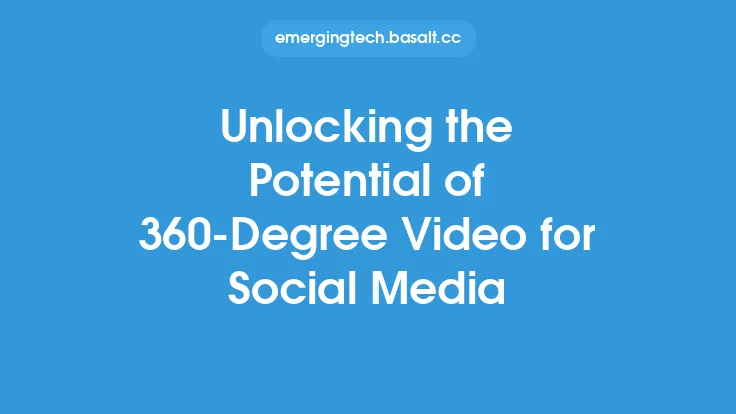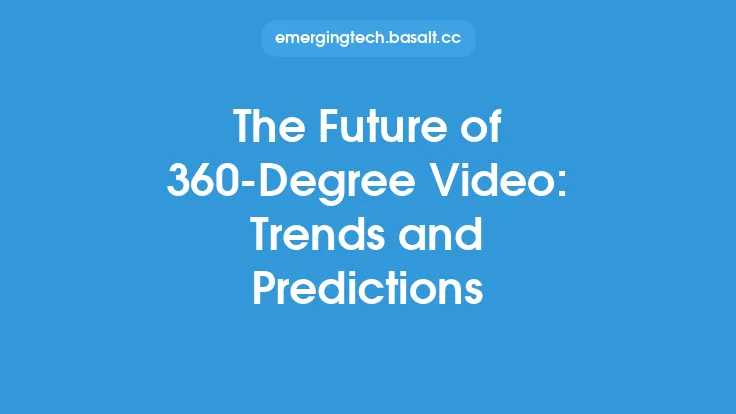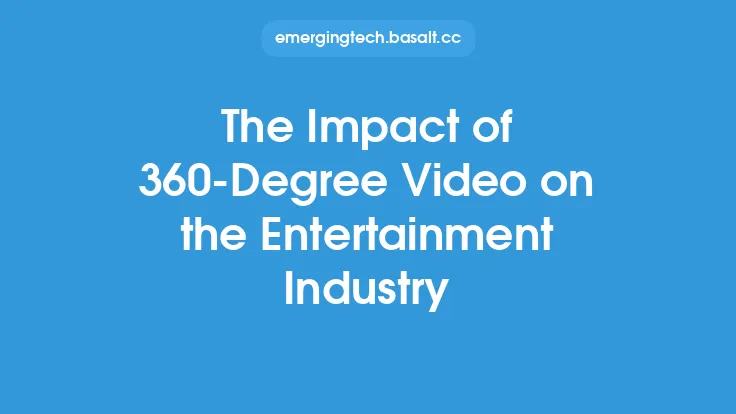The concept of 360-degree video has been gaining popularity in recent years, and its impact on user engagement is a topic of great interest. This type of video content provides an immersive experience, allowing viewers to explore and interact with the environment in a more engaging and interactive way. The psychology behind 360-degree video is complex, and it affects user engagement in various ways.
Introduction to 360-Degree Video
360-degree video, also known as spherical video or immersive video, is a type of video content that captures a 360-degree view of a scene. This is achieved using specialized cameras that can record video in all directions simultaneously. The resulting video can be viewed on a variety of devices, including computers, smartphones, and virtual reality (VR) headsets. When viewed on a VR headset, 360-degree video provides a fully immersive experience, allowing the viewer to feel as if they are part of the scene.
The Psychology of Immersion
The key to understanding the psychology of 360-degree video is to consider the concept of immersion. Immersion refers to the state of being completely engaged and absorbed in an experience. When viewers are immersed in a 360-degree video, they are more likely to feel as if they are part of the scene, rather than just passive observers. This can lead to increased emotional engagement, as viewers are more likely to feel a sense of presence and connection to the environment. The sense of presence is a critical factor in determining the level of immersion, and it is influenced by various factors, including the quality of the video, the realism of the environment, and the level of interactivity.
The Role of Attention in 360-Degree Video
Attention plays a crucial role in the psychology of 360-degree video. When viewers are presented with a 360-degree video, they are free to explore the environment in any direction they choose. This can lead to a phenomenon known as "attentional overload," where the viewer is overwhelmed by the sheer amount of visual information available. However, this can also lead to increased engagement, as viewers are more likely to be actively exploring and interacting with the environment. The way in which attention is directed and focused can have a significant impact on the overall experience, and it is influenced by various factors, including the use of visual cues, audio cues, and interactive elements.
The Impact of Interactivity on User Engagement
Interactivity is a key factor in determining the level of user engagement in 360-degree video. When viewers are able to interact with the environment, they are more likely to feel a sense of agency and control. This can lead to increased emotional engagement, as viewers are more likely to feel invested in the experience. Interactivity can take many forms, including the ability to navigate the environment, interact with objects, and influence the narrative. The level of interactivity can have a significant impact on the overall experience, and it is influenced by various factors, including the use of hotspots, interactive elements, and branching narratives.
The Neuroscience of 360-Degree Video
The neuroscience of 360-degree video is a complex and fascinating topic. Research has shown that the brain processes 360-degree video in a unique way, with increased activity in areas of the brain associated with spatial awareness, attention, and emotional processing. The use of VR headsets can also have a significant impact on the brain, with research showing that it can alter the way in which the brain processes visual information. The neuroscience of 360-degree video is still a relatively new field of study, but it has the potential to provide valuable insights into the psychology of user engagement.
Technical Considerations
From a technical perspective, 360-degree video is a complex and challenging medium. The production of 360-degree video requires specialized equipment, including cameras, stitching software, and editing tools. The distribution of 360-degree video also requires specialized platforms, including VR headsets, smartphones, and computers. The technical considerations of 360-degree video can have a significant impact on the overall experience, and it is influenced by various factors, including the resolution, frame rate, and codec used.
Best Practices for Creating Engaging 360-Degree Video
Creating engaging 360-degree video requires a deep understanding of the psychology of user engagement. Best practices include the use of high-quality video, realistic environments, and interactive elements. The use of visual and audio cues can also help to direct attention and focus, while the use of hotspots and branching narratives can increase interactivity. The level of immersion can also be increased through the use of VR headsets, which provide a fully immersive experience. By following these best practices, creators can increase user engagement and provide a more immersive and interactive experience.
Conclusion
The psychology of 360-degree video is a complex and fascinating topic. By understanding the factors that influence user engagement, including immersion, attention, interactivity, and neuroscience, creators can design more effective and engaging 360-degree video experiences. The technical considerations of 360-degree video can also have a significant impact on the overall experience, and it is essential to consider these factors when producing and distributing 360-degree video content. As the field of 360-degree video continues to evolve, it is likely that we will see new and innovative ways to increase user engagement and provide a more immersive and interactive experience.





